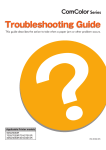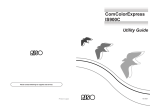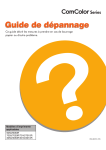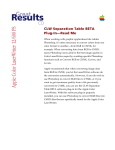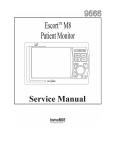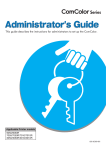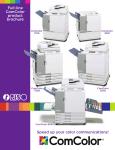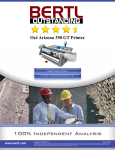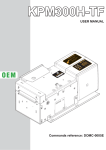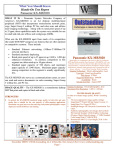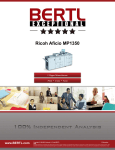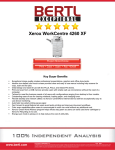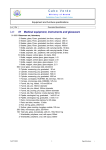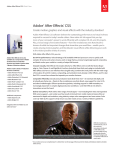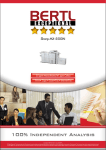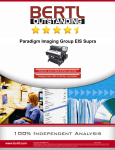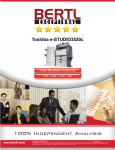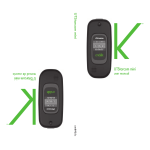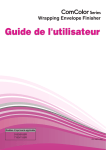Download View a 1mb pdf in a new window
Transcript
RISO ComColor®9050 150-ppm Monochrome; 150-ppm Color Print ▪ Copy ▪ Scan Key Buyer Benefits Heatless, non-impact printing method uses only 1,000 watts when printing, saving both the environment and money spent on energy bills Extremely cost effective – average costs are less than a half cent per monochrome page and less than three cents for color pages Network scanning of up to 40 opm at 600 dpi No slow-down for duplex printing – prints the same speed in duplex as it does in simplex Multi-function finishing provides a large array of booklet-making options such as punching, stapling, stitching, folding, and arranging documents 8.5-inch LCD Touch Screen designed for maximum readability and easy navigation Three drawers accommodate paper sizes up to 11” x 17”, plus a 1,000 sheet standard tray for a total of 2,500 sheet input Line smoothing eliminates jagged edges Gamma controls allows user to adjust contrast and color density of images that may be ill-defined, too dark, or two light Can cluster five printers together (with one as the master printer) to automatically allocate print jobs for top efficiency Energy Star qualified, contains no destructive halogens such as chlorine, fluorine, iodine, or bromine, motherboard/cables/wires. Very small footprint: less than 48” wide and 41” high Standard hard drive capacity of 160 GB www.BERTL.com Copyright © 2008 BERTL, Inc. All Rights Reserved. The license under which this document is made available and applicable law prohibit any reproduction or further transmission of any portion of this document. This document may only be viewed electronically through the www.BERTL.com Web site and may not be stored in electronic or hard copy format. Any reproduction of trademarks is strictly prohibited. BERTL accepts no responsibility for any inaccuracies or omissions contained in this document. August 2009 RISO ComColor 9050 www.BERTL.com What’s Inside Table of Contents BERTL Galaxy Star Rating .................................................................................. 3 Introduction .......................................................................................................... 4 Device Overview ....................................................................................... 4 Device General Specifications .................................................................. 5 Print ....................................................................................................................... 7 Background ............................................................................................... 7 Network Bandwidth ................................................................................... 7 Print Productivity ....................................................................................... 7 What We Liked.......................................................................................... 9 Copy .................................................................................................................... 10 Background ............................................................................................. 10 Copy Productivity .................................................................................... 13 Document Feeder Productivity ............................................................... 14 What We Liked........................................................................................ 15 Image Quality ..................................................................................................... 16 BERTL DTP Booklet ............................................................................... 16 DTP Booklet Image Quality .................................................................... 20 What We Liked........................................................................................ 22 Ease of Use......................................................................................................... 23 Accessibility ............................................................................................ 23 Accessibility Features Summary............................................................. 23 Programming the Control Panel ............................................................. 24 What We Liked........................................................................................ 24 Print Drivers ............................................................................................ 25 Client Utilities .......................................................................................... 30 IS900c Controller .................................................................................... 31 Routine Maintenance .............................................................................. 33 What We Liked........................................................................................ 35 Media Handling .................................................................................................. 36 Media-Input Features .............................................................................. 35 Media-Output Features ........................................................................... 35 What We Liked........................................................................................ 35 Copyright © 2009 BERTL Inc. September 29, 2009 All Rights Reserved. The license under which this document is made available and applicable law prohibit any reproduction or further transmission of any portion of this document. This document may only be viewed electronically through the www.BERTL.com Web site and may not be stored in electronic or hard copy format. Any reproduction of trademarks is strictly prohibited. BERTL accepts no responsibility for any inaccuracies or omissions contained in this document. Page 2 August 2009 RISO ComColor 9050 www.BERTL.com What’s Inside Table of Contents (Cont.) Security ............................................................................................................... 37 Security-Features Summary ................................................................... 37 What We Liked ....................................................................................... 37 Summing Up....................................................................................................... 38 About BERTL .................................................................................................... 39 BERTL Galaxy© Star Rating Riso ComColor 9050 B uild Quality A dministratio n Security Wo rkflo w Finishing Ease o f Use M edia Handling Co pying Scanning P rinting Image Quality Features P rice 0.0 1.0 Copyright © 2009 BERTL Inc. 2.0 3.0 4.0 5.0 September 29, 2009 All Rights Reserved. The license under which this document is made available and applicable law prohibit any reproduction or further transmission of any portion of this document. This document may only be viewed electronically through the www.BERTL.com Web site and may not be stored in electronic or hard copy format. Any reproduction of trademarks is strictly prohibited. BERTL accepts no responsibility for any inaccuracies or omissions contained in this document. Page 3 August 2009 RISO ComColor 9050 www.BERTL.com Introduction “Many industry observers say that the future of production printing is inkjet [and] RISO provides that breakthrough,” said RISO President Todd Deluca, “with our unique and powerful ComColor high-speed inkjet printers.” In June 2009, RISO Inc. introduced the ComColor series, which RISO claims to be among “the world’s fastest cutsheet inkjet printers.” These printers are supposed to be not only fast, but durable, space efficient, and eco-friendly. Furthermore, RISO also foretells these printers saving their users a significant amount of money with their low TCO (Total Cost of Ownership). The leader of this pack is the lightning-fast ComColor 9050. This printing virtuoso can print with speeds of up to 150 ppm and can handle a 500,000 page monthly production cycle. Furthermore, due to RISO’s FORCEJET imaging system, the ComColor series consume little power as it requires no heat to fuse ink to the paper. This leads the ComColor 9050 to be phenomenally cost-effective, with averages of less than half a cent for monochrome and less than three cents for color pictures. Device Features Summary RISO ComColor® 9050 Suggested List Price $45,995 Monthly Duty Cycle 500,000 pages Engine speed Scanning Speed Maximum Scanning Width Zoom Reduction/ Enlargement Preset Reduction/ Enlargement Modes (A4) 150/150 ppm (black-andwhite/color) (8.5” x 11”) 146/146 ppm (black-andwhite/color) 40 ppm Platen Glass: 303 mm X 432 mm (1115/16” x 17”); ADF: 297 mm x 432 mm (1111/16” x 17”) 25-400%/0.1% 50%, 64.7%, 77.2%, 78.5%, 121.4%, 129.4%, 156.5%, 200% 2 min. 45 sec. or less at room temperature of 68 F The ComColor 9050 also boasts strong image quality features, with its exact piezo drop-on-demand inkjet technology. It even has a line smoothing feature to eliminate jagged edges and gamma controls to allow adjusting of contrast and color density. This production device also comes with a plethora of finishing options such as stapling, folding, and stitching and can combine with four other devices to maximize printing efficiency for particularly enormous jobs automatically load balance of jobs across up-to five engines. Warm-up time Below is the list pricing for the ComColor models. Resolution 600 x 600 dpi Halftones 256 (8-bit) CYMK • • • • • ComColor 9050 - $45,995 ComColor 7050 - $39,995 ComColor 7010 - $36,995 ComColor 3050 - $27,995 ComColor 3010 - $24,995 First Copy Out Time 5.0/6.5 sec. (black-and-white/color) Maximum Media Size (Main Body) 13”x19.2” (330.2mm x 482.6 mm) Maximum Media Weight (Main Body) Duplex 56-lb. bond (210 gsm) Standard All of the ComColor models take the same optional accessories (except the finisher will not connect to the 7010 and 3010). In the following test report, BERTL takes an in-depth look at the RISO ComColor 9050, testing its productivity, image quality, and ease of use. RISO’s ComColor® 9050 as tested by BERTL. Copyright © 2009 BERTL Inc. September 29, 2009 All Rights Reserved. The license under which this document is made available and applicable law prohibit any reproduction or further transmission of any portion of this document. This document may only be viewed electronically through the www.BERTL.com Web site and may not be stored in electronic or hard copy format. Any reproduction of trademarks is strictly prohibited. BERTL accepts no responsibility for any inaccuracies or omissions contained in this document. Page 4 August 2009 RISO ComColor 9050 www.BERTL.com Introduction GENERAL SPECIFICATIONS RISO ComColor® 9050 Main Unit Guaranteed Print Area³ Standard: Margin width of 1/8” (3 mm); Maximum: Margin width of 1/16” (1 mm) Oil-based pigment ink (Cyan, Magenta, Yellow, Black) Paper Weight Standard Tray: 12-lb bond to 56-lb bond (46 to 210 GSM), plain paper Resolution Standard: 300 dpi (main scanning direction) x 300 dpi (sub-scanning direction) Fine: 300 dpi (main scanning direction) x 600 dpi (sub-scanning direction) Paper Feed Method/Paper Tray Capacity4 Standard: 500 sheets (Height up to 2 3/8” [60 mm]); Option: 1,000 sheets (when using the optional Auto-Control Stacking Tray or Wide Stacking Tray) Number of Gray Levels For each CMYK color (8 gray levels) Continuous Printing Capacity 9,999 sheets Data Processing Resolution Standard: 300 dpi x 300 dpi Fine: 300 dpi x 600 dpi Line smoothing: 600 dpi x 600 dpi Output Tray Capacity4 Warm-up Time 2 min. 45 sec. or less (at room temperature of 68 degrees F (20 degrees Celsius) Standard: 500 sheets (Height up to 2 3/8” [60 mm]) Option: 1,000 sheets (when using the optional Auto-Control Stacking Tray or Wide Stacking Tray) Power Source AC 100-240 V, 10-5 A, 50-60Hz Monochrome: 8 sec or less¹ (when copying A4-R/Letter-R orientation using monochrome mode); Color: 8 sec or lessº (when copying A4-R/Letter-R orientation using color mode) Power Consumption Max: 1,000 W Ready5: 250 W Sleep: Max 45 W Hibernate6: Max, 1W Operating Noise Max, 60 dB (when printing) A4-R Simplex: 150 ppm; Duplex: 150 ppm (75 sheets); Letter-R Simplex: 146 ppm; Duplex: 146 ppm 73 sheets); A4 Simplex: 110 ppm; Duplex: 110 ppm (55 sheets); Letter Simplex: 116 ppm; Duplex: 116 ppm (58 sheets); B4/Legal Simplex: 90 ppm; Duplex: 90 ppm (45 sheets); A3 Simplex: 80 ppm; Duplex: 80 ppm (40 sheets); Ledger Simplex: 78 ppm; Duplex: 78 ppm (39 sheets) Operating Environment Temperature: 59ºF to 86ºF (15ºC to 30ºC); Humidity: 40% to 70% RH (noncondensing) Dimensions (W x D x H) In use: 46 1/6” x 27 3/8” x 40 3/16” (1,170 x 695 x1,020 mm) Weight 386 lb (175 kg) Required Space With front cover and feed tray extended: 47 5/8” x 48 7/16” x 40 3/16” (1,210 x 1,230 x 1,020 mm) Color Support Full color Print Type Line-type inkjet system Ink Type First Print Time Continuous Print Speed² Duplex Printing Standard Paper Size Standard Tray Maximum: 13 3/8” x 21 5/8” (340 x 550 mm); Minimum 3 9/16” x 5 13/16” (90 x 148 mm) Feed Tray Maximum: 11 11/16” x 17” (297 x 420mm); Minimum 7 3/16” x 7 3/16” (182 x 182 mm) Printable Area Maximum 12 3/8” x 21 9/16” (314 x 548 mm) Copyright © 2009 BERTL Inc. With face down tray and standard tray stored: 45 ¼” x 27 3/8” x 39” (1,150 x 695 x 990 mm) ¹ Within 10 minutes after the last print job ² When using plain paper and recycled paper (85 GSM [23-lb bond]) and density setting 3 (Standard). Chart used: Print measurement pattern (Color measurement sample 2 [JEITA] standard patter [J6]) ³ The margin when printing envelopes is 10 mm (3/8”). For ComColor 7050/7050R, the guaranteed area when printing images is the area endorsed within 3mm (1/8”) of the edges of the paper 4 When using plain paper and recycled paper (85 GSM [23-lb bond]) 5 When not printing 6 Denoted as “Stand-by” in user manual September 29, 2009 All Rights Reserved. The license under which this document is made available and applicable law prohibit any reproduction or further transmission of any portion of this document. This document may only be viewed electronically through the www.BERTL.com Web site and may not be stored in electronic or hard copy format. Any reproduction of trademarks is strictly prohibited. BERTL accepts no responsibility for any inaccuracies or omissions contained in this document. Page 5 August 2009 RISO ComColor 9050 www.BERTL.com Introduction Integrated System Controller Specifications PDL RISO RINC/CII Supported Protocols TCP/IP, HTTP, HTTPs (SSL), DHCP, ftp, lpr, IPP, SNMP, Port 9100 (RAW port) Supported Operating Systems Microsoft Windows 2000, Microsoft Windows XP (32-bit version), Microsoft Windows Server 2003 (32-bit version), Microsoft Windows 2000 Server, Microsoft Windows Vista (32-bit version) Installed Fonts None Emulation None Network Interface Ethernet 1000BASE-T, 100BASE-TX, 10BASE-T (2ch) CPU Intel Celeron M440 (1.86 GHz) Memory Capacity 1 GB Hard Disk¹ Capacity 160 GB; Available space 140 GB Operating System Linux Optional External Adobe® PostScript® 3™ System Controller PDL PDF (1.7), PCL/PCL XL (PCL 5c 1.38), TIFF (6.0), PPML (PPML (2.1) Supported Protocols TCP/IP, HTTP, HTTPS (SSL), DHCP, ftp, lpr, IPP, SNMP, Port 9100 (RAW port) Supported Operating Systems Microsoft ® Windows ® XP (32-bit version), Microsoft ® Windows ® Server 2003 (32-bit version), Microsoft ® Windows ® 2000 Server, Microsoft ® Windows ® Vista (32-bit version), Mac OSX 10.4, OSX 10.5 Installed Fonts PS: 139; PCL 80 Emulation: None Network Interface Ethernet 1000BASE-T, 100BASE-TX, 10BASE-T (2ch) CPU Intel ® Core ™ Duo E6400 (2.13 GHz) Memory Capacity Hard Disk Operating System 2 GB Capacity 320 GB Linux ¹One gigabyte (GB) is calculated as 1 billion bytes Device Length with Optional Configurations None 47.74 Inches (1,210mm) With scanner 48.04 " Inches (1,220mm) With offset stacker 48.82 " Inches (1,2420mm) With finisher 90.36 " Inches (2,295mm) With scanner and finisher 90.36 " Inches ((2,295mm) Copyright © 2009 BERTL Inc. September 29, 2009 All Rights Reserved. The license under which this document is made available and applicable law prohibit any reproduction or further transmission of any portion of this document. This document may only be viewed electronically through the www.BERTL.com Web site and may not be stored in electronic or hard copy format. Any reproduction of trademarks is strictly prohibited. BERTL accepts no responsibility for any inaccuracies or omissions contained in this document. Page 6 August 2009 RISO ComColor 9050 www.BERTL.com Print BACKGROUND First Page Out Time (seconds) Printing passed copying as the primary method of reproducing documents years ago. Today, printing is just as important—if not more important—than copying. Connectivity Most devices include Ethernet and USB connectivity outof-the-box. Some devices include parallel connections. In addition, many devices provide a selection of optional connectivity choices such as Wireless 802.11b or g (g is the faster, preferred standard), Bluetooth for cell phone or PDA connectivity, PictBridge photo printing for printing directly from a digital camera, and FireWire for high-speed local connectivity. Page Description Languages (PDLs) PCL is the page description language (PDL) provided by most printer and MFP suppliers. Some manufacturers charge for a PostScript upgrade or provide PostScript Level 3 emulation (clone). Still other manufacturers provide genuine Adobe PostScript Level 3 and bundle in PCL. A few manufacturers also include their own PDL, which are typically based loosely on the Microsoft Windows/GDI printing technology of old. These Windows or GDI drivers often offer significant productivity advantages over traditional PCL and PostScript print drivers, since the bulk of the processing is handled by the more powerful desktop PC, rather than by the less wellequipped printer processor itself. NETWORK-BANDWIDTH/PRINT FILE SIZE Network-Bandwidth/Print File Sizes (MB) Native File Size GDI PS 1-page digital photo PDF 4.48 9.42 MB 5.64 MB 4 page Passport Form PDF 0.08 127 KB 395 KB 16-page Magazine in PDF 1.78 7.12 MB 3.33 MB 22-page Excel Worksheet 0.12 157 KB 4.75 MB 32-page Text-Based PowerPoint 0.23 4.44 MB 2.06 MB 32-page Graphic Intensive PowerPoint 4.20 13.01 MB 22.5 MB 38-page Form Word Document 0.91 5.64 MB 21.9 MB 50-page Text-Based PDF 0.17 664 KB 1.54 MB 50-page duplex textbased PDF 0.17 664 KB 1.54 MB Copyright © 2009 BERTL Inc. Job List Media Size GDI PS 1-page photo print Letter 16.06 15.71 4-page passport form PDF Letter 13.68 13.18 16-page Magazine PDF Letter 15.09 14.70 22-page Excel Worksheet Letter 15.14 26.27 32-page text-based PowerPoint Letter 14.39 16.49 32-page graphic-intensive PowerPoint Letter 15.59 21.18 38-page Word form Letter 14.89 21.67 50-page text-based PDF Letter 12.18 15.92 50-page duplex text- based PDF Letter 20.27 20.33 Total Job Time (seconds) Job List Media Size Mode GDI PS 1-page digital photo Letter 1:1 16.47 15.71 4-page passport form PDF Letter 1:1 15.93 13.98 16-page Magazine PDF Letter 1:1 35.18 20.87 22-page Excel Worksheet Letter 1:1 23.77 34.69 32-page text-based PowerPoint Letter 1:1 26.81 29.02 32-page graphic-intensive PowerPoint Letter 1:1 31.27 33.74 38-page simplex Word form Letter 1:1 29.86 36.67 50-page text-based PDF Letter 1:1 31.77 35.47 50-page duplex text PDF Letter 1:2 55.96 39.74 September 29, 2009 All Rights Reserved. The license under which this document is made available and applicable law prohibit any reproduction or further transmission of any portion of this document. This document may only be viewed electronically through the www.BERTL.com Web site and may not be stored in electronic or hard copy format. Any reproduction of trademarks is strictly prohibited. BERTL accepts no responsibility for any inaccuracies or omissions contained in this document. Page 7 August 2009 RISO ComColor 9050 www.BERTL.com Print Simplex GDI Print Productivity Black-and-White Text – Normal Mode (Pages Per Minute) Simplex PS Print Productivity Black-and-White Text – Normal Mode (Pages Per Minute) SETS SETS PAGES 1 3 5 10 20 30 40 50 PAGES 1 3 5 10 20 30 40 50 1 4.9 13.9 21.8 38.0 60.7 75.7 86.4 94.4 1 3.8 10.8 17.1 30.8 51.1 65.5 76.2 84.6 2 9.5 25.4 38.0 60.7 86.4 100.6 109.7 115.9 2 7.4 20.1 30.8 51.1 76.2 91.2 101.2 108.3 3 13.9 35.1 50.6 75.7 100.6 113.1 120.5 125.4 3 10.8 28.3 41.8 65.5 91.2 105.0 113.6 119.4 4 17.9 43.4 60.7 86.4 109.7 120.5 126.7 130.8 4 14.0 35.5 51.1 76.2 101.2 113.6 121.0 125.9 5 21.8 50.6 68.9 94.4 115.9 125.4 130.8 134.3 5 17.1 41.8 58.8 84.6 108.3 119.4 125.9 130.1 6 25.4 56.9 75.7 100.6 120.5 129.0 133.7 136.7 6 20.1 47.6 65.5 91.2 113.6 123.7 129.4 133.1 7 28.8 62.5 81.5 105.6 124.0 131.6 135.8 138.4 7 22.9 52.7 71.2 96.7 117.7 126.9 132.0 135.3 8 32.0 67.4 86.4 109.7 126.7 133.7 137.4 139.8 8 25.7 57.4 76.2 101.2 121.0 129.4 134.1 137.1 9 35.1 71.8 90.7 113.1 129.0 135.3 138.7 140.9 9 28.3 61.6 80.7 105.0 123.7 131.4 135.7 138.4 10 38.0 75.7 94.4 115.9 130.8 136.7 139.8 141.7 10 30.8 65.5 84.6 108.3 125.9 133.1 137.1 139.5 20 60.7 100.6 115.9 130.8 139.8 143.1 144.7 145.8 20 51.1 91.2 108.3 125.9 137.1 141.2 143.4 144.8 30 75.7 113.1 125.4 136.7 143.1 145.3 146.5 147.2 30 65.5 105.0 119.4 133.1 141.2 144.2 145.7 146.6 40 86.4 120.5 130.8 139.8 144.7 146.5 147.4 147.9 40 76.2 113.6 125.9 137.1 143.4 145.7 146.8 147.5 50 94.4 125.4 134.3 141.7 145.8 147.2 147.9 148.3 50 84.6 119.4 130.1 139.5 144.8 146.6 147.5 148.1 Duplex GDI Print Productivity Black-and-White Text – Normal Mode (Pages Per Minute) Duplex PS Print Productivity Black-and-White Text – Normal Mode (Pages Per Minute) SETS SETS PAGES 1 3 5 10 20 30 40 50 PAGES 1 3 5 10 20 30 40 50 1 3.0 8.3 12.9 22.3 34.9 43.0 48.7 52.9 1 3.0 8.5 13.7 25.0 42.8 56.2 66.5 74.7 2 5.7 15.0 22.3 34.9 48.7 56.1 60.8 63.9 2 5.8 16.1 25.0 42.8 66.5 81.5 91.8 99.4 3 8.3 20.6 29.3 43.0 56.1 62.5 66.2 68.7 3 8.5 22.9 34.6 56.2 81.5 95.9 105.2 111.7 4 10.7 25.3 34.9 48.7 60.8 66.2 69.3 71.3 4 11.1 29.1 42.8 66.5 91.8 105.2 113.4 119.0 5 12.9 29.3 39.4 52.9 63.9 68.7 71.3 73.0 5 13.7 34.6 49.9 74.7 99.4 111.7 119.0 123.9 6 15.0 32.8 43.0 56.1 66.2 70.4 72.7 74.2 6 16.1 39.7 56.2 81.5 105.2 116.5 123.1 127.4 7 17.0 35.9 46.1 58.7 67.9 71.7 73.8 75.1 7 18.5 44.3 61.6 87.1 109.7 120.2 126.2 130.1 8 18.8 38.5 48.7 60.8 69.3 72.7 74.6 75.7 8 20.7 48.6 66.5 91.8 113.4 123.1 128.6 132.1 9 20.6 40.9 51.0 62.5 70.4 73.5 75.2 76.2 9 22.9 52.5 70.8 95.9 116.5 125.5 130.5 133.7 10 22.3 43.0 52.9 63.9 71.3 74.2 75.7 76.7 10 25.0 56.2 74.7 99.4 119.0 127.4 132.1 135.1 20 34.9 56.1 63.9 71.3 75.7 77.3 78.1 78.6 20 42.8 81.5 99.4 119.0 132.1 137.1 139.8 141.4 30 43.0 62.5 68.7 74.2 77.3 78.4 79.0 79.3 30 56.2 95.9 111.7 127.4 137.1 140.7 142.5 143.7 40 48.7 66.2 71.3 75.7 78.1 79.0 79.4 79.6 40 66.5 105.2 119.0 132.1 139.8 142.5 143.9 144.8 50 52.9 68.7 73.0 76.7 78.6 79.3 79.6 79.9 50 74.7 111.7 123.9 135.1 141.4 143.7 144.8 145.5 Copyright © 2009 BERTL Inc. September 29, 2009 All Rights Reserved. The license under which this document is made available and applicable law prohibit any reproduction or further transmission of any portion of this document. This document may only be viewed electronically through the www.BERTL.com Web site and may not be stored in electronic or hard copy format. Any reproduction of trademarks is strictly prohibited. BERTL accepts no responsibility for any inaccuracies or omissions contained in this document. Page 8 August 2009 RISO ComColor 9050 www.BERTL.com Print WHAT WE LIKED Simplex GDI Print Productivity Color Graphics – Normal Mode (Pages Per Minute) • SETS PAGES 1 3 5 10 20 30 40 50 1 3.8 10.8 17.0 29.8 47.6 59.5 68.0 74.3 2 7.5 19.9 29.8 47.6 68.0 79.2 86.4 91.4 3 10.8 27.5 39.7 59.5 79.2 89.1 95.0 98.9 4 14.0 34.0 47.6 68.0 86.4 95.0 100.0 103.2 5 17.0 39.7 54.1 74.3 91.4 98.9 103.2 106.0 6 19.9 44.6 59.5 79.2 95.0 101.8 105.5 107.9 7 22.6 49.0 64.0 83.2 97.8 103.9 107.2 109.3 8 25.1 52.9 68.0 86.4 100.0 105.5 108.5 110.4 9 27.5 56.4 71.3 89.1 101.8 106.8 109.5 111.2 10 29.8 59.5 74.3 91.4 103.2 107.9 110.4 111.9 20 47.6 79.2 91.4 103.2 110.4 113.0 114.4 115.2 30 59.5 89.1 98.9 107.9 113.0 114.8 115.7 116.3 40 68.0 95.0 103.2 110.4 114.4 115.7 116.5 116.9 50 74.3 98.9 106.0 111.9 115.2 116.3 116.9 117.2 Simplex PS Print Productivity Color Graphics – Normal Mode (Pages Per Minute) • • • • • Tested simplex black-and-white network-print speed was as fast as 148.3 ppm using the GDI driver and 148.1 using the PostScript driver, both drivers exceeded RISO’s rated print speed of 146 ppm for Letter-R simplex. Tested duplex black-and-white network-printer productivity was up to 79.9 ppm using the GDI driver, while the PostScript driver closely matched RISO’s rated speed of 146 ppm duplex with a speed of 145.5 ppm. Tested simplex color network Productivity was as fast as 117.2 ppm using the GDI driver and 145.1 with the PostScript driver. Test First-Page-Out-Time was as low as 12.18 with the GDI driver and 13.18 in PostScript. In BERTL’s job stream test the Postscript driver completed the stream job test in 2 minutes and 24:20 seconds, running at 111.52 ppm, which translates to an efficiency rate of 76.38%. GDI print controller for efficient processing of most print jobs or adding the Adobe PostScript 3 for duplex or graphics-intensive jobs. WHAT WE WOULD LIKE TO SEE • BERTL was exceptionally satisfied with the RISO ComColor 9050’s office suite performance testing in network-printer mode. SETS PAGES 1 3 5 10 20 30 40 50 1 2.8 8.2 13.2 24.2 41.6 54.7 64.9 73.1 2 5.6 15.5 24.2 41.6 64.9 79.9 90.2 97.9 3 8.2 22.1 33.5 54.7 79.9 94.3 103.8 110.4 4 10.7 28.1 41.6 64.9 90.2 103.8 112.1 117.9 5 13.2 33.5 48.5 73.1 97.9 110.4 117.9 122.9 6 15.5 38.5 54.7 79.9 103.8 115.3 122.0 126.5 7 17.8 43.0 60.1 85.5 108.4 119.0 125.2 129.2 8 20.0 47.2 64.9 90.2 112.1 122.0 127.6 131.3 9 22.1 51.1 69.2 94.3 115.3 124.5 129.6 132.9 10 24.2 54.7 73.1 97.9 117.9 126.5 131.3 134.3 20 41.6 79.9 97.9 117.9 131.3 136.4 139.2 140.9 30 54.7 94.3 110.4 126.5 136.4 140.1 142.0 143.2 40 64.9 103.8 117.9 131.3 139.2 142.0 143.5 144.4 50 73.1 110.4 122.9 134.3 140.9 143.2 144.4 145.1 Copyright © 2009 BERTL Inc. September 29, 2009 All Rights Reserved. The license under which this document is made available and applicable law prohibit any reproduction or further transmission of any portion of this document. This document may only be viewed electronically through the www.BERTL.com Web site and may not be stored in electronic or hard copy format. Any reproduction of trademarks is strictly prohibited. BERTL accepts no responsibility for any inaccuracies or omissions contained in this document. Page 9 August 2009 RISO ComColor 9050 www.BERTL.com Copy BACKGROUND Nearly all multi-functional systems on the market today provide digital copying, while many desktop printers offer it as an option. Despite the fact that many devices provide a wide range of digital-copying capabilities, from image manipulation to page insertion, most typical copy jobs actually consist of a single set of a simplex document that is five pages or less, with no finishing, and no imagequality manipulation. Small Simple Jobs Although most multi-functional devices provide a wide range of copying features, most users are not willing to navigate through countless screen menus in order to get to the point where they can actually press the Start key. There are two components of copy-job productivity: 1) user productivity, and 2) device productivity. BERTL encourages enterprises to also consider the impact of user productivity, along with device productivity. Device productivity only includes the time it takes from the press of the Start key until the final copy exits the device, and does not take into account the time that it takes a user to program and start the copy job. However, the easier the job, the easier it is to program; users will also take less time to program jobs as they acclimate to the controls and/or create job programs. And, of course, some users are more astute and capable than others. Consequently, these uncontrolled factors introduce a high degree of variability. However, of course, a device that takes twice as long to produce the first copy affects the job productivity of each and every user and job. Large, Complex Jobs Even with large copy jobs—where it seems engine speed plays the largest role—user productivity should be taken into account. For example, the user is less likely to wait at the copier for larger and more complex jobs. Factors that enhance user productivity include such features as easy job programming; a scan-ahead feature so that users can program and scan jobs while other jobs are printing; fast original scanning so that users can more quickly return to their desks with their originals; the ability to build a job using a mix of different-sized originals scanned from both the document feeder and platen; and job notification at the computer desktop when the copy job is completed (thus eliminating the guesswork of when to return to the copier to collect the job). Copyright © 2009 BERTL Inc. The ComColor 9050 comes standard with a USB port for storing scanned data. Users can save scan files as either a PDF, TIFF, or JPEG. Above and below: The RISO ComColor 9050’s platen (above) and document feeder (below), with the document feeder’s cover opened in order to expose the feeder’s misfeed-access area. September 29, 2009 All Rights Reserved. The license under which this document is made available and applicable law prohibit any reproduction or further transmission of any portion of this document. This document may only be viewed electronically through the www.BERTL.com Web site and may not be stored in electronic or hard copy format. Any reproduction of trademarks is strictly prohibited. BERTL accepts no responsibility for any inaccuracies or omissions contained in this document. Page 10 August 2009 RISO ComColor 9050 www.BERTL.com Copy Users can control all of the copy settings from this screen. Options include Color Mode, Reproduction Size, Feed Tray, Originals, Scanning Level, and Duplex/Simplex. Above and below: Users can register up to 4 frequently used functions to the direct access area of the [Basic] screen or up to 16 functions to the [Selections] screen. Copyright © 2009 BERTL Inc. The functions tab section describes the copy functions that are configured within the [Functions] screen. Above and below: Users can set various finishing settings by selecting an output image from the Select Layout screens. September 29, 2009 All Rights Reserved. The license under which this document is made available and applicable law prohibit any reproduction or further transmission of any portion of this document. This document may only be viewed electronically through the www.BERTL.com Web site and may not be stored in electronic or hard copy format. Any reproduction of trademarks is strictly prohibited. BERTL accepts no responsibility for any inaccuracies or omissions contained in this document. Page 11 August 2009 RISO ComColor 9050 www.BERTL.com Copy Users can configure the staple and punch settings with optional multifunctional finisher directly from the control panel. Within the Color Mode setting users can select the [Auto] setting which is designed for documents with a mixture of color and black-and-white pages, the auto color mode senses the presence or absence of color and controls ink usage to reduce ink consumption and save cost. The Mono-Color Print setting allows users to print their documents in a single color. Users can specify from black, cyan and magenta. The Original button found on the [Basic] copy screen allows users to indicate the type of original being copied to so as to generate the best possible copy output. Options include for Line/Photo, Line, Photo, and Map/Pencil Mode with Dot Process set to off, 70 lpi, and 100 lpi. With the multi-up option users can impose several pages of an original onto one sheet. Users can add preprinted sheets or colored paper that has been loaded in the tray, to the front and back of the printouts as covers. The touch screen displaying feed tray options. Here users can make a tray a default, change the paper settings, and set a tray to manual or auto. Copyright © 2009 BERTL Inc. September 29, 2009 All Rights Reserved. The license under which this document is made available and applicable law prohibit any reproduction or further transmission of any portion of this document. This document may only be viewed electronically through the www.BERTL.com Web site and may not be stored in electronic or hard copy format. Any reproduction of trademarks is strictly prohibited. BERTL accepts no responsibility for any inaccuracies or omissions contained in this document. Page 12 August 2009 RISO ComColor 9050 www.BERTL.com Copy Copy Job Time # of originals MONOCHROME MODE Time In Seconds CPM 10 1 sided to 1 sided 14.00 42.9 10 1 sided to 2 sided 20.00 30.0 10 2 sided to 1 sided 29.50 20.3 10 2 sided to 2 sided 33.00 18.2 COLOR MODE The ComColor 9050 offers users the ability to stamp the page number and date on the header or footer. 14.00 42.9 10 1 sided to 2 sided 20.00 30.0 14.00 42.9 10 Advertised speeds are always quoted using the simplest route—in-and-out of a device. Of course, users often apply finishing options, incorporate different media sizes and types into the document, print in duplex, and add other elements that can affect speed. In the chart below, BERTL tests how different modes—mixed-size original mode and duplex mode—affect auto document-feeder mixed-sized printing mode productivity. In order to assess copier productivity, BERTL ran a series of copy jobs in order to determine auto document-feeder scanning speed, the affect of the first set out on overall engine speed, and whether specific job attributes affect engine throughput capability. Each job was set up by feeding media from the shortest media route to the shortest available output destination. A separate test examines how adding finishing/output destinations affects productivity. First Copy Out Time* 1 Simplex Original 1 sided to 1 sided AUTO COLOR MODE COPY PRODUCTIVITY Number of Originals 10 Black-andWhite Mode Seconds Color Mode Seconds 8.50 8.50 2 Simplex Original 10.00 (Duplex Model) *Using the auto document feeder. Copyright © 2009 BERTL Inc. 10.00 1 sided to 1 sided Simplex Black-and-White Copier Productivity (Pages Per Minute) SETS Pages 1 3 5 10 20 30 40 50 1 7.1 18.5 27.4 42.9 59.7 68.6 74.2 78.0 2 13.2 31.2 42.9 59.7 74.2 80.8 84.5 87.0 3 18.5 40.3 52.8 68.6 80.8 85.9 88.6 90.4 4 23.2 47.3 59.7 74.2 84.5 88.6 90.9 92.2 5 27.4 52.8 64.7 78.0 87.0 90.4 92.2 93.4 6 31.2 57.2 68.6 80.8 88.6 91.6 93.2 94.1 7 34.5 60.8 71.7 82.9 89.9 92.5 93.9 94.7 8 37.6 63.8 74.2 84.5 90.9 93.2 94.4 95.1 9 40.3 66.4 76.3 85.9 91.6 93.7 94.8 95.4 10 42.9 68.6 78.0 87.0 92.2 94.1 95.1 95.7 20 59.7 80.8 87.0 92.2 95.1 96.1 96.6 96.9 30 68.6 85.9 90.4 94.1 96.1 96.8 97.1 97.3 40 74.2 88.6 92.2 95.1 96.6 97.1 97.4 97.6 50 78.0 90.4 93.4 95.7 96.9 97.3 97.6 97.7 September 29, 2009 All Rights Reserved. The license under which this document is made available and applicable law prohibit any reproduction or further transmission of any portion of this document. This document may only be viewed electronically through the www.BERTL.com Web site and may not be stored in electronic or hard copy format. Any reproduction of trademarks is strictly prohibited. BERTL accepts no responsibility for any inaccuracies or omissions contained in this document. Page 13 August 2009 RISO ComColor 9050 www.BERTL.com Copy Duplex Black-and-White Copier Productivity (Pages Per Minute) SETS Duplex Color Copier Productivity (Pages Per Minute) SETS Pages 1 3 5 10 20 30 40 50 Pages 1 6.0 14.4 20.0 28.2 35.6 38.9 40.9 42.1 1 2 3 4 1 3 5 10 20 30 40 50 6.0 14.4 20.0 28.2 35.6 38.9 40.9 42.1 10.7 22.2 28.2 35.6 40.9 43.0 44.1 44.9 14.4 27.0 32.7 38.9 43.0 44.5 45.4 45.9 17.5 30.3 35.6 40.9 44.1 45.4 46.0 46.4 2 5.3 22.2 28.2 35.6 40.9 43.0 44.1 44.9 3 7.6 27.0 32.7 38.9 43.0 44.5 45.4 45.9 4 9.6 30.3 35.6 40.9 44.1 45.4 46.0 46.4 5 20.0 32.7 37.5 42.1 44.9 45.9 46.4 46.7 5 11.5 32.7 37.5 42.1 44.9 45.9 46.4 46.7 6 22.2 34.6 38.9 43.0 45.4 46.2 46.6 46.9 6 13.1 34.6 38.9 43.0 45.4 46.2 46.6 46.9 7 24.0 36.0 40.0 43.6 45.7 46.5 46.8 47.1 7 14.6 36.0 40.0 43.6 45.7 46.5 46.8 47.1 8 25.6 37.2 40.9 44.1 46.0 46.6 47.0 47.2 9 27.0 38.1 41.5 44.5 46.2 46.8 47.1 47.3 10 28.2 38.9 42.1 44.9 46.4 46.9 47.2 47.3 20 35.6 43.0 44.9 46.4 47.2 47.4 47.6 47.7 8 16.0 37.2 40.9 44.1 46.0 46.6 47.0 47.2 9 17.3 38.1 41.5 44.5 46.2 46.8 47.1 47.3 10 18.5 38.9 42.1 44.9 46.4 46.9 47.2 47.3 30 38.9 44.5 45.9 46.9 47.4 47.6 47.7 47.8 20 26.7 43.0 44.9 46.4 47.2 47.4 47.6 47.7 40 40.9 45.4 46.4 47.2 47.6 47.7 47.8 47.8 30 31.3 44.5 45.9 46.9 47.4 47.6 47.7 47.8 50 42.1 45.9 46.7 47.3 47.7 47.8 47.8 47.9 40 34.3 45.4 46.4 47.2 47.6 47.7 47.8 47.8 Document Feeder Productivity 50 36.4 45.9 46.7 47.3 47.7 47.8 47.8 47.9 BERTL also takes the user into account and looks at how document-feeder productivity affects the amount of time a user has to wait at the device before they can walk away with their originals. Simplex Color Copier Productivity (Pages Per Minute) Document Feed Speed SETS Pages 1 3 5 10 20 30 40 50 # of originals MONOCHROME MODE Time In Seconds OPM* 1 7.1 18.5 27.4 42.9 59.7 68.6 74.2 78.0 10 Simplex Originals 15.00 40.0 2 13.2 31.2 42.9 59.7 74.2 80.8 84.5 87.0 5 Duplex Originals 20.00 15.0 3 18.5 40.3 52.8 68.6 80.8 85.9 88.6 90.4 10 Mixed-Size Originals 25.4 23.6 4 23.2 47.3 59.7 74.2 84.5 88.6 90.9 92.2 5 27.4 52.8 64.7 78.0 87.0 90.4 92.2 93.4 10 Simplex Originals 15.00 40.0 6 31.2 57.2 68.6 80.8 88.6 91.6 93.2 94.1 5 Duplex Originals 20.00 30.0 7 34.5 60.8 71.7 82.9 89.9 92.5 93.9 94.7 8 37.6 63.8 74.2 84.5 90.9 93.2 94.4 95.1 9 40.3 66.4 76.3 85.9 91.6 93.7 94.8 95.4 10 42.9 68.6 78.0 87.0 92.2 94.1 95.1 95.7 20 59.7 80.8 87.0 92.2 95.1 96.1 96.6 96.9 30 68.6 85.9 90.4 94.1 96.1 96.8 97.1 97.3 40 74.2 88.6 92.2 95.1 96.6 97.1 97.4 97.6 50 78.0 90.4 93.4 95.7 96.9 97.3 97.6 97.7 Copyright © 2009 BERTL Inc. COLOR MODE *Originals per minute. September 29, 2009 All Rights Reserved. The license under which this document is made available and applicable law prohibit any reproduction or further transmission of any portion of this document. This document may only be viewed electronically through the www.BERTL.com Web site and may not be stored in electronic or hard copy format. Any reproduction of trademarks is strictly prohibited. BERTL accepts no responsibility for any inaccuracies or omissions contained in this document. Page 14 August 2009 RISO ComColor 9050 www.BERTL.com Copy per copy environment will save money as the click will now be charged as a monochrome click and not a color click. Document-Finishing Penalty # of originals Finishing Selection Time In Secs 1 Set Time (Secs) Penalty Per Set (Secs) 10/5 Corner Staple 23.00 11.40 -0.52 10/5 Side Staples 25.00 11.80 -0.22 8/5 Saddle-Stitch Booklet 40.00 14.80 0.08 10/5 Covers and Inserts 48.00 16.40 0.48 • Users can specify the color mode from auto-color, black, cyan and magenta. The entire image will appear in cyan or magenta. WHAT WE WOULD LIKE TO SEE • BERTL was exceptionally satisfied with the RISO ComColor 9050’s copying capabilities. WHAT WE LIKED • Tested black-and-white FPOT as fast as 8.50 seconds in simplex copier mode, and as fast as 10 seconds in duplex copier mode. • Tested color FPOT as fast as 8.00 seconds in simplex copier mode, and as fast as 10.00 seconds in duplex copier mode. • Tested black-and-white copier productivity was up to 97.7 ppm in simplex mode and up to 47.9 ppm in duplex mode. Tested color productivity in simplex mode was as fast as 97.7 ppm, and as fast as 47.9 ppm in duplex color mode. Minimal document-finishing penalty when applying Corner Staple, Side Staples, Saddle-Stitch Booklet, and Covers and Inserts Fast document-feeder speeds of up to 40 opm in both color and monochrome using simplex mode and up to 15 opm in duplex mode, matching RISO’s rated speed of 40 opm. Auto Document Feeder with 100 sheet capacity. Automatic single/double-sided scanning capabilities. RISO rated copy time of up to 11.5 seconds. Interrupt Copy allows users to interrupt a job currently being printed to copy a more urgent job. Copy and Pause function is useful for high-volume copying. One sheet is copied and then copying stops, enabling the user to check the result of the settings. The ADF Scan and Pause function allows users to copy a large quantity of originals that cannot be loaded at one time in the ADF to be copied as one job. Up to 1,000 one-sided originals or 500 two-sided originals can be copied as one job. The Book Shadow Erase function will erase shadows that appear in the center of copies when copying an open book. • • • • • • • • • • • This device has the ability to auto recognize color which is a new function not previously supported on the HC model. Monochrome pages will now be printed in K and not in CMYK. Customers who are in a cost Copyright © 2009 BERTL Inc. September 29, 2009 All Rights Reserved. The license under which this document is made available and applicable law prohibit any reproduction or further transmission of any portion of this document. This document may only be viewed electronically through the www.BERTL.com Web site and may not be stored in electronic or hard copy format. Any reproduction of trademarks is strictly prohibited. BERTL accepts no responsibility for any inaccuracies or omissions contained in this document. Page 15 August 2009 RISO ComColor 9050 www.BERTL.com Image Quality THE BERTL DTP BOOKLET BERTL’s production-printing analysts ran a broad range of tests in order to evaluate all aspects of image quality and functionality using a hand-picked selection of standard test targets and scientific matching charts. BERTL also produced copies of the 32-page BERTL Digital Test Portfolio (DTP) that contains a variety of text, lines, gradations and synthetic images printed onto a variety of substrates. This DTP project was composed entirely with Adobe Creative Suite® 3 Design Premium – the ultimate creative toolset, with Adobe® InDesign® CS3 for page layout, Photoshop® CS3 Extended for specialized image editing, Illustrator® CS3 for vector graphics creation, Flash® CS3 Professional for interactive design, Dreamweaver® CS3 for Web design and development, and Acrobat® 8 Professional for Adobe® PDF workflows. All test targets and graphics were integrated into Adobe® InDesign® using their default palettes and native resolutions. The BERTL DTP Volume 2 was designed specifically with layout, imaging, color, evaluation tools and media selection in mind, to truly test the abilities of digital presses. This challenging document was able to illustrate the RISO ComColor® 9050’s image-quality capabilities. Page Thumb If possible, all image-quality tests were printed on 256 gsm gloss cover stock with various intermittent stocks for comparative value. The booklet was produced both as a finished booklet and as a straight-through print test for image-quality evaluation. Media Description Front Cover Coated Cover The cover contains 100% area coverage and features a composite cyan gradient. A mosaic consisting of tiny thumbnails of test charts are positioned to the left of the white BERTL logo. Page 2 Coated Cover Page 2 is the BERTL DTP introductory page that contains font changes and trapezoidal 20% halftone images. Page 3 Opaque Vellum BERTL DTP Volume 2 Contents page contains a color font and rotated black Times New Roman font samples ranging in size from 2- to 20-pt. Page 4 Opaque Vellum Intentionally left blank Copyright © 2009 BERTL Inc. September 29, 2009 All Rights Reserved. The license under which this document is made available and applicable law prohibit any reproduction or further transmission of any portion of this document. This document may only be viewed electronically through the www.BERTL.com Web site and may not be stored in electronic or hard copy format. Any reproduction of trademarks is strictly prohibited. BERTL accepts no responsibility for any inaccuracies or omissions contained in this document. Page 16 August 2009 RISO ComColor 9050 www.BERTL.com Image Quality Page 5 Coated Body Page 5 is used for graphic applications as well as a sample of the ability to print lighter solid colors at 100 percent in full bleed. The background is a red composite mix of magenta, yellow and black. The BERTL logo is a lighter red mix of magenta and yellow, and positioned down the right hand edge of the page. All text is outlined with a 1 pt. white line. Page 6 Coated Body BERTL Production Test Methodology in black 9 pt. Times New Roman text on a white background. The sidebar consists of a rotated 100 pt. Futura font, printed in 30% grayscale. Page 7 Coated Body BERTL Production Test Methodology, with a mix black, 9 pt. Times New Roman text and white 12 pt. Bold Futura text. Thumbnails of test targets are shadowed. Table consists of black 1 pt. lines Page 8 Coated Body BERTL Production Test Methodology with a mix of elements that is similar to that of page 7. A 100 pt. Futura header is printed in 30% grayscale. Page 9 Coated Body BERTL Production Test Methodology with a mix of elements that is similar to that of page 7. A 100 pt. Futura header is printed in 30% grayscale. Page 10 Coated Body The last page of the BERTL Production Test Methodology has a solid black background with a mix of negative standard, bold and italic Times New Roman font samples ranging in size from 2- to 22-pt. Pages 11-12 Coated Body N2 Cafeteria from ISO 12640 Graphic technology – Prepress digital data exchange – CYMK standard color image data (CYMK/SCID). Image with complicated geometric shapes. Suitable for evaluating the result of image processing. Pages 13-14 Coated Body N5 Bicycle from ISO 12640 Graphic technology – Prepress digital data exchange – CYMK standard color image data (CYMK/SCID). Image in both color and grayscale of a (penny-farthing) bicycle, resolution charts and other items containing fine detail used to evaluate the sharpness of reproduction and the results of image processing. Copyright © 2009 BERTL Inc. September 29, 2009 All Rights Reserved. The license under which this document is made available and applicable law prohibit any reproduction or further transmission of any portion of this document. This document may only be viewed electronically through the www.BERTL.com Web site and may not be stored in electronic or hard copy format. Any reproduction of trademarks is strictly prohibited. BERTL accepts no responsibility for any inaccuracies or omissions contained in this document. Page 17 August 2009 RISO ComColor 9050 www.BERTL.com Image Quality Page 15 Coated Body N4 Wine and Tableware from ISO 12640 Graphic technology – Prepress digital data exchange – CYMK standard color image data (CYMK/SCID). Image in both color and grayscale of glassware and silverware used to evaluate the reproduction characteristics of highlight tones and neutral colors. Page 16 Coated Body N3 Fruit Basket from ISO 12640 Graphic technology – Prepress digital data exchange – CYMK standard color image data (CYMK/SCID). Image in both color and grayscale of a fruit basket cloth and wood used to evaluate the reproduction of brown colors and fine texture. Page 17 Coated Body N6 Orchid from ISO 12640 Graphic technology – Prepress digital data exchange – CYMK standard color image data (CYMK/SCID). Image in both color and grayscale of an orchid with background vignettes used to evaluate reproduction of highlight and shadow vignettes. Page 18 Coated Body N7 Musicians from ISO 12640 Graphic technology – Prepress digital data exchange – CYMK standard color image data (CYMK/SCID). Image in both color and grayscale of three women used to evaluate the reproduction of different skin tones and fine image detail. Page 19 Coated Body N8 Candle from ISO 12640 Graphic technology – Prepress digital data exchange – CYMK standard color image data (CYMK/SCID). "Low-key" image in both color and grayscale of a room scene containing miscellaneous objects used to evaluate dark colors, particularly browns and greens. Page 20 Coated Body Pantone® test chart containing 30 color chips that represent real world colors in the CMYK color space used to evaluate color fidelity. Coated Body Synthetic image S6 from ISO 12640 is 2,512 pixels by 3,048 pixels and contains 8 strips, each of which is a continuous vignette 256 pixels by 3,032 pixels. The vignettes range from 0% to 100% dot area for each of the four separation colors and the two- and three-color combinations of cyan, magenta and yellow. Used for extended evaluation of color fidelity. Coated Body Synthetic image S8 from ISO 12640 consists of 8 rows of 13 patches and represents the basic data set as defined in ISO 12642. It is 2,288 pixels by 1,056 pixels. The physical arrangement of all patches in each set is the same to allow the patches to be on common centers which facilitate automated colorimetric or densitometric reading equipment. All patches in the primary set are 160 pixels square and separated from the adjacent patch by 16 pixels. Those in the alternate set are 120 pixels square and separated by 12 pixels. In addition there is a border of 8 pixels (6 in the alternate set) on the outside of each group. Thus, when groups are butted next to each other the 16 pixel (or 12 pixel) spacing is preserved. Each patch, when output at the stated resolution, will be 10 mm square. Used for extended evaluation of color fidelity. Page 21 Page 22 Copyright © 2009 BERTL Inc. September 29, 2009 All Rights Reserved. The license under which this document is made available and applicable law prohibit any reproduction or further transmission of any portion of this document. This document may only be viewed electronically through the www.BERTL.com Web site and may not be stored in electronic or hard copy format. Any reproduction of trademarks is strictly prohibited. BERTL accepts no responsibility for any inaccuracies or omissions contained in this document. Page 18 August 2009 RISO ComColor 9050 www.BERTL.com Image Quality Pages 23-24 Coated Body imageXpert Printer 600 dpi Target Version 5.1 consists of various sizes of negative and positive lines, negative and positive dots, solid areas, negative and positive text, and color gradations. Used to evaluate negative and positive dot and line control. Page 25 Coated Body BERTL test chart that consists of various widths of negative text and negative and positive lines intersecting at various angles. Used to evaluate the quality of negative text and registration at the intersection of the various lines. Page 26 Coated Body Northlight Images Black and White Test Print. The image is based on two landscape pictures that show up different aspects of B/W print quality. The graduated blocks and 21 step wedges (5% increments) also give a more absolute test. In the small sample from the Hood Canal image at the bottom, there is meant to be some visible noise - it is part of the image. Used to evaluate black-and-white print quality. Page 27 Coated Body Northlight Images Grayscale Linearization (Gray Gamma 2.2) test image (300 dpi 13x19 cm) has circular gradients on it, both positive and negative, that allow a more precise measurement of where non-linearity occurs in prints. Used to evaluate the linearity of grayscale prints. Page 28 Coated Body Credits Page acknowledges BERTL partners whose imaging tools were used in the evaluation. Page 29 Opaque Vellum The About BERTL page has a red BERTL logo positioned down the left side of the black text. Page 30 Opaque Vellum Intentionally left blank Page 31 Coated Cover Page 31 is used for graphic aesthetics as well as a sample of the ability to print lighter solid colors at 100 percent in full bleed. The background is pure cyan at 20%. The BERTL logo is 100% cyan and positioned down the right edge of the page. The logo and text are outlined with a 1 pt. black line. Back Cover Coated Cover The back cover contains 100% area coverage and features a composite cyan gradient. A mosaic consisting of tiny thumbnails of test charts are positioned across the top. Negative Times New Roman font samples ranging in size from 2- to 22-pt. are positioned across the lower half of the cover. Copyright © 2009 BERTL Inc. September 29, 2009 All Rights Reserved. The license under which this document is made available and applicable law prohibit any reproduction or further transmission of any portion of this document. This document may only be viewed electronically through the www.BERTL.com Web site and may not be stored in electronic or hard copy format. Any reproduction of trademarks is strictly prohibited. BERTL accepts no responsibility for any inaccuracies or omissions contained in this document. Page 19 August 2009 RISO ComColor 9050 www.BERTL.com Image Quality BERTL DTP BOOKLET IMAGE QUALITY Print Halftones The RISO COMCOLOR® 9050 is not designed to generate beautiful glossy finished documents with color matching capabilities. Depending on the type of paper used users can expect to generate very decent image quality. However, this device is designed for applications where the output is disposable and used for a short period of time. Suggested applications are internal documents, bills, and transpromotional mailing pieces. In this test, BERTL printed the DTP Booklet and compared the quality of output to that of other devices. IMAGE DENSITY Min. Gradation* Max. Gradation** Black 10 100 Cyan 10 100 Yellow 10 100 Magenta 10 100 *Minimum gradation is on a scale of 10 – 100 percent in 10 percent increments. The best possible minimum gradation is 10 percent. **Maximum gradation is on a scale of 10 – 100 percent in 10 percent increments. The best possible maximum gradation is 100 percent. BERTL uses a calibrated X-Rite reflection densitometer to measure the density of a black image. The instrument reports density in the range of 0.0 (absolute white) to 2.5 (infinite blackness). In general, image density that is greater than 1.0 generally has contrast that is acceptable for readability, and the higher the reading the better. Test Result - The RISO ComColor® 9050 produced prints with an image density of .96. Currently, there are a handful of printers that can produce prints with 1.7+ black image density, while average image-density readings range from 1.4 to 1.6. Recently, a color printer produced images with a density of 1.84—the highest density (or the “blackest” print) ever recorded by BERTL’s analysts. Density of Solid Areas* Copy Density Print Density Black .81 .96 Cyan .77 .66 Yellow .55 .51 Magenta .84 .77 *Density is on a scale of 0 to 2.5, with 2.5 being the best possible. Copy & Print Resolution* Copy Resolution Print Resolution Vertical Horizontal Vertical Horizontal Black 5.6 5.6 2.0 2.0 Cyan -- -- 2.0 2.0 Yellow -- -- 2.0 2.0 Magenta -- -- 2.0 2.0 *Line Pairs per Millimeter. For copy resolution, higher is better (range, 2.0-8.0); for printer resolution, lower is better (range, 1.0-5.0). Copyright © 2009 BERTL Inc. Copy Halftones Min. Gradation* Max. Gradation** Black 10 90 Cyan 10 90 Yellow 10 90 Magenta 10 90 *Minimum gradation is on a scale of 10 – 100 percent in 10 percent increments. The best possible minimum gradation is 10 percent. **Maximum gradation is on a scale of 10 – 100 percent in 10 percent increments. The best possible maximum gradation is 100 percent. TEXT BERTL’s DTP booklet contains arrays of negative and positive text in various sizes ranging in size from 2 to 20 pts. Fonts were also rotated 90 and 180 degrees. The accuracy of text reproduction is paramount throughout the entire spectrum of graphic designers, book manufacturers, marketing departments, technical data, financial reporting, billing departments and all cross sections of the printing industry. Expectations for quality text reproduction have risen with the advancement in technology. Nobody likes to see jagged text on pages, even if it is a small font. Test Result – The RISO ComColor® 9050 produced both serif and non-serif fonts (negative, positive and rotated) that were readable by eye down to 4 point in size. When viewed under 10x magnification, all positive font sizes and rotations were readable down to 3 point in size, while negative font sizes were readable down to 5 point. FINE LINES AND DOTS The BERTL DTP booklet contains elements that are used to evaluate fine-line graphics on both the x and y axis. These elements consist of negative and positive lines and dots of various sizes and colors. To the right is the test pattern used to evaluate the dotcontrol capabilities of a printer. As lines are composed of a series of dots, the ability of a device to control dots is directly related to its ability to produce fine lines. The ability to finely control the placement of dots also is September 29, 2009 All Rights Reserved. The license under which this document is made available and applicable law prohibit any reproduction or further transmission of any portion of this document. This document may only be viewed electronically through the www.BERTL.com Web site and may not be stored in electronic or hard copy format. Any reproduction of trademarks is strictly prohibited. BERTL accepts no responsibility for any inaccuracies or omissions contained in this document. Page 20 August 2009 RISO ComColor 9050 www.BERTL.com Image Quality an indication of the device’s ability to produce gradients and halftones and maintain a clean edge with curved fine lines. The most extreme portion of the dot quality evaluation is the ability of the device to print both negative and positive 1- and 2-pixel dots. Negative/Positive Dots* Line Width (points) % of Dots Printed 1 pixel Cyan 100 1 pixel Yellow 100 1 pixel Magenta 100 1 pixel Black 100 1 pixel Black Neg 100 2x2 pixel Black 100 2x2 pixel Black Neg 100 Checkerboard apparent? No *On a scale of 0 – 100%. The higher the percentage, the better. Other elements of the BERTL DTP are a series of negative, positive and color lines in various widths. A series of diagonal lines is used to evaluate stair stepping (ragged edges or “jaggies”), while a grid composed of colored lines is used to evaluate color trapping of the intersecting lines. Test Result – The RISO ComColor® 9050 was able to produce prints of black at 2-pixel prints while the cyan, magenta, and yellow were accurately reproduced at 1 pixel. The RISO ComColor® 9050 also accurately printed negative and positive lines of various widths. The RISO ComColor® 9050 prints did display some small visible stair stepping of the negative and positive diagonal lines of various widths. Negative/Positive Lines* Line Width (points) Negative Positive Vertical Horizontal Vertical Horizontal 1 √ √ √ √ 2 √ √ √ √ 3 √ √ √ √ 4 √ √ √ √ 5 √ √ √ √ 6 √ √ √ √ A “√” mark indicates the device was able to print the line width correctly. *Chart cells containing an “x” indicate that the printer was not able to print the line width correctly. Overall, the fewer “x’s,” the better the Copyright © 2009 BERTL Inc. image quality. If no cells are marked with an “x,” then the device was able to print all line widths correctly. GRAYSCALE Along with precise dot control, a printer’s ability to produce seamless grayscale images is the key to its ability to produce today’s complex documents that contain a mix of illustrative and photographic elements. Additionally, the ability to produce high-quality halftones more often than not precludes the use of expensive color images in most documents—a key to controlling the cost of printing. BERTL designed components of the DTP specifically for the evaluation of halftone quality: • Grayscale and color versions of ISO synthetic or natural images are included so that BERTL can evaluate the ability of the device to convert and print a color image versus print a grayscale version of the same color image. • Linear grayscale strips were printed in order to evaluate smooth transitions between gradations. • Grayscale linearization prints are used to precisely identify the tonal values where linearization is inconsistent. • A professional photo montage is mixed with challenging contrasted images and geometric elements in order to evaluate the device’s ability to regulate print contrast over a wide range of conditions, all on a single page. Test Result - BERTL technicians examined every grayscale element in the printed DTP and found dark and over-saturation through several sections of the images evaluated. However, the RISO ComColor® 9050 features many image-quality adjustments, and BERTL feels that grayscale color saturation and darkness can be tailored to suit virtually any application. IMAGE REGISTRATION One element of BERTL’s DTP features is designed to specifically address the evaluation of registration. Two identical images are laid out on consecutive pages in the DTP. BERTL technicians analyze the printed output to evaluate front-to-rear, top-to-bottom, side-to-side and sheetto-sheet registration. imageXpert test charts are printed fontto-back in order to evaluate image registration. imageXpert printer image-quality test charts Test Result - BERTL technicians evaluated a number of documents printed by the RISO COMCOLOR® 9050 and found that front-to-rear (duplex) registration and sheet-to- September 29, 2009 All Rights Reserved. The license under which this document is made available and applicable law prohibit any reproduction or further transmission of any portion of this document. This document may only be viewed electronically through the www.BERTL.com Web site and may not be stored in electronic or hard copy format. Any reproduction of trademarks is strictly prohibited. BERTL accepts no responsibility for any inaccuracies or omissions contained in this document. Page 21 August 2009 RISO ComColor 9050 www.BERTL.com Image Quality sheet registration was ~0.3 mm vertically and ~0.5 mm horizontally. COLOR REGISTRATION WHAT WE LIKED Many elements of BERTL’s DTP are designed to address the evaluation of color registration. Grids composed of colored lines are used to evaluate color trapping of intersecting lines. A series of negative and positive multicolored elements are used to evaluate color dot placement and minute color transitions. • The RISO ComColor® 9050 produced prints with consistently good overall image quality. Prints displayed a durable matted finish, even on plain paper. • Test Result – BERTL evaluators noted trapping anomalies where red lines intersect blue lines. BERTL Analysts were very satisfied with the color registration. • This device has the ability to auto recognize color which is a new function not previously supported on the HC model. Monochrome pages will now be printed in K and not in CMYK. Customers who are in a cost per copy environment will save money as the click will now be charged as a monochrome click and not a color click. • The RISO ComColor 9050 is not designed to generate glossy fished documents. The Print head The ComColor 9050’s print heads are SOLID FILL Pages 5, 10, 25 and 31 of the BERTL DTP were specifically designed to test a device’s ability to produce anomaly-free edge-to-edge prints with solid fill, a demanding task for most printers to produce on a consistent basis. The ability to produce consistent solid fill becomes especially crucial in the production environment where common jobs entail the printing of complex documents (such as BERTL’s DTP) and long runs. Test Result – The RISO ComColor® 9050 printed entire pages of solid fill with no observable anomalies. The edgeto-edge solid fill colors were opaque and consistently solid. IMAGE PERMANENCE/TONER CRACKING The test file printed by the RISO ComColor® 9050 was used specifically by BERTL for evaluating spot colors and solids. The best test for toner cracking is with a densely covered sheet. The most creative marketing materials that require folding utilize heavy coverage. These particular sheets were folded and scored in both directions and there was no more or less cracking on either fold – inside or outside. Whenever possible, they were printed on coated 256 gsm media. • • designed to last up to 6 million impressions. This device is intended for applications where the output is disposable and used for a short period of time. This device is not intended for users looking for glossy finished documents. WHAT WE WOULD LIKE TO SEE • BERTL was satisfied with the image quality produced by the RISO ComColor 9050’s. Test Result – As with most prints produced by ink-based imaging technology, so no cracking was observed in the hard-creasing test. The ink used by the RISO ComColor is saturated into the paper that no cracking is visible. BERTL analyst also noted that when the surface of the paper was scratched with a metal object such as a key, no flaking occurred. The ComColor 9050’s print heads are designed to last up to 6 million impressions. Copyright © 2009 BERTL Inc. September 29, 2009 All Rights Reserved. The license under which this document is made available and applicable law prohibit any reproduction or further transmission of any portion of this document. This document may only be viewed electronically through the www.BERTL.com Web site and may not be stored in electronic or hard copy format. Any reproduction of trademarks is strictly prohibited. BERTL accepts no responsibility for any inaccuracies or omissions contained in this document. Page 22 August 2009 RISO ComColor 9050 www.BERTL.com Ease of Use ACCESSIBILITY In the United States, Section 508 legislation prohibits government agencies from purchasing devices that are not accessible to those with physical impairments. For this reason—and the corporate world’s increased focus on delivering a better work environment for all—many manufacturers are increasingly providing more userfriendly features for physically-impaired users. Common design features include tilting control panels, which give wheelchair-bound users a better view of the screen, and larger display options for those with impaired vision. Voice navigation and Braille also are becoming increasingly popular. Easy access to the paper path for misfeed removal and front access to toner supplies also make a device more user-friendly. The right side of the control panel contains various hard keys, including keys for Interrupt, Reset, Wake Up as well as a numerical keypad for entering number of copies and fax numbers. Hard keys on the left include function keys, counter key, and mode key. USER ACCESSIBILITY TO DEVICE CONTROLS Routine maintenance tasks performed at front of device Yes Remote control-panel software No The large, full-color touch screen is easy to access from a wheelchair and the hard button controls on the unit itself are on a slight tilt and easy to read from a sitting position. Menus and icons on the touch screen are all large, often with a visual cue making navigation for the visually impaired or mentally challenged easier. Audible “beeps” indicating error conditions Yes USER ACCESSIBILITY FOR PAPER REFILLING Control panel optimization for visually impaired No Voice-recognition software No Additional accessibility features No The paper drawers can be easily refilled with one hand. The paper guide lock is at the back of the drawer, which makes users lean over a bit more, but not unduly difficult. The main feed unit is very easy for wheelchair users to refill. Accessibility Features Summary USER ACCESSIBILITY FOR PAPER JAM REMOVAL Paper jam removal is a simple process for those in a wheelchair. There are no hidden jam points and all access areas are at a comfortable height and angle for access from the side of the device. WHAT WE LIKED: • • • The RISO ComColor® 9050 is equipped with a large 8 .5 inch LCD touch panel. Copyright © 2009 BERTL Inc. The controls are easy to use. The process for removing paper jams and refilling paper supplies is simple. Replacing ink supplies was also a process that could easily be achieved in a wheelchair. WHAT WE WOULD LIKE TO SEE: • BERTL was very satisfied with the RISO ComColor 9050’s accessibility capabilities. September 29, 2009 All Rights Reserved. The license under which this document is made available and applicable law prohibit any reproduction or further transmission of any portion of this document. This document may only be viewed electronically through the www.BERTL.com Web site and may not be stored in electronic or hard copy format. Any reproduction of trademarks is strictly prohibited. BERTL accepts no responsibility for any inaccuracies or omissions contained in this document. Page 23 August 2009 RISO ComColor 9050 www.BERTL.com Ease of Use PROGRAMMING THE CONTROL PANEL Visit a few manufacturers’ showrooms, and you will see a wide range of control panels and touch screens. The most rudimentary consist of a selection of hard keys and an LCD screen that can often be challenging to navigate. On the other hand, some control panels that utilize hard keys and LCD screens can actually be easier to use than touch screens. However, hard-key/LCD panel systems that require users to scroll through various settings and make a selection can also often be challenging to use. Among touch screens, some utilize a menu-driven system, while others utilize an icon-based system. Some menudriven touch screens can involve many complicated submenus that can be difficult to navigate. Most manufacturers try to keep their control panels and touch screens consistent across their MFPs and printers, so that users do not have to spend time learning how to use a new control panel when moving from device to device. The control panel displays all of the device’s available functions. Options include Printer, Copy, and Scanner. Users can easily select the device function of their choosing by pressing on one of the three function keys or the desired function right on the touch screen. A control panel’s ease of use—or lack of—can often have a significant affect on user productivity. The harder it is to select frequently used options such as duplexing, document finishing, etc., the more time the user has to spend programming the device and the less productive they are. In the chart below, BERTL assesses how many steps are required to make these commonplace settings. Selections Required for Frequently Used Copy Functions Photo Mode 2 Corner Staple 2 Reduce to 64% 2 1:2 2 2:2 2 Copied Front and Rear Covers 6 *Users can customize the device functions and add shortcuts directly on the control panel which can cut down on the steps required to accomplish the functions noted above. WHAT WE LIKED • • • • • • Copyright © 2009 BERTL Inc. The touch screen provides animated instructions that guide the user through most user/device functions and processes. Control panel screen is well-designed. Large, clearly labeled, and intuitively designed. The most popular functions of the copier are all on the first screen, allowing for greater convenience for the user. Auto Color mode offers users the ability to distinguish color or black originals. This feature is very useful for count charge customers. The newly added function [Pencil/Map mode is useful for faint, or originals with fine details. Users can customize and save the functions which they more commonly used. Users can save up to 4 direct access selections. Administrators can force people to login into the user interface (Login Enforced). With this function users can customize how the device options appear on the control panel and set user defaults. September 29, 2009 All Rights Reserved. The license under which this document is made available and applicable law prohibit any reproduction or further transmission of any portion of this document. This document may only be viewed electronically through the www.BERTL.com Web site and may not be stored in electronic or hard copy format. Any reproduction of trademarks is strictly prohibited. BERTL accepts no responsibility for any inaccuracies or omissions contained in this document. Page 24 August 2009 RISO ComColor 9050 www.BERTL.com Ease of Use WHAT WE WOULD LIKE TO SEE • BERTL found the RISO ComColor® 9050’s control panel very easy to use. • We would have liked to have seen support for LDAP embedded in the device to support users how perform scan to email. However, RISO has a tool which they have developed that allows administrators to import email address directly onto the device. POSTSCRIPT PRINT DRIVER As with control panels and touch screens, print-driver design can vary enormously from manufacturer-tomanufacturer. And, as with control panels and touch screens, how easy it is—or isn’t—to make selections in the print driver and navigate through it can significantly affect user productivity. Most vendors provide an emulation of PCL (printer control language) developed by the Hewlett-Packard Company. Some may also provide an emulation of PostScript, which was developed by Adobe Systems Incorporated, or they may license PostScript directly from Adobe. While the Adobe PostScript driver is not the most user-friendly of print drivers, the advantage is that many users are already familiar with it. Alternately, some manufacturers may use an emulation of PostScript and design their own printdriver user interface, or may license PostScript from Adobe and also design their own print-driver interface. BERTL evaluated the RISO ComColor 9050 with the external ComColorExpress IS900C Controller. Copyright © 2009 BERTL Inc. This first tab [Basic] shown above provides the most frequently used features required for workgroup printing. These include paper size, orientation, input tray selection, paper type, and color output mode. Users also have the option of choosing a quick print setting for simplex or duplex printing. The [Layout] tab provides users with the option of setting the document layout, orientation, output size, imposition, multi-up, binding margin, scaling and rotating. September 29, 2009 All Rights Reserved. The license under which this document is made available and applicable law prohibit any reproduction or further transmission of any portion of this document. This document may only be viewed electronically through the www.BERTL.com Web site and may not be stored in electronic or hard copy format. Any reproduction of trademarks is strictly prohibited. BERTL accepts no responsibility for any inaccuracies or omissions contained in this document. Page 25 August 2009 RISO ComColor 9050 www.BERTL.com Ease of Use The [Trays] tab provides users with the option of selecting the paper tray to be used when printing. Users have the option of selecting the input tray, tray selection per page, paper type and mixed output size among other options. From the [Finishing] tab users can utilize the finishing tab to take full advantage of the ComColor 9050’s full array of finishing options, such as binding, stapling, punching, folding, etc. Copyright © 2009 BERTL Inc. The [Image] tab provides settings for adjusting image resolution, color output mode, brightness, and contrast. The [Forms] tab provides advanced options for printing registered forms in the ComColorExpress IS900C and prints output data overlaid on forms. September 29, 2009 All Rights Reserved. The license under which this document is made available and applicable law prohibit any reproduction or further transmission of any portion of this document. This document may only be viewed electronically through the www.BERTL.com Web site and may not be stored in electronic or hard copy format. Any reproduction of trademarks is strictly prohibited. BERTL accepts no responsibility for any inaccuracies or omissions contained in this document. Page 26 August 2009 RISO ComColor 9050 www.BERTL.com Ease of Use The [Annotation] tab allows users to add header and footer text to output data when printing. The [Shifting] tab provides adjustments for the vertical and horizontal margins of the original images to be printed. Copyright © 2009 BERTL Inc. The [Workflow] tab is used to configure the output destination of the original data, output operation and notification method which is used to send a job status email message to a specified email address. The [Color] tab enables users to adjust the color settings for image data that is hard to reproduce. Within the [Color] tab users can change the rendering intent and color profiles that are used to map the image compression and color conversion in order to reproduce colors as close as possible to original print. September 29, 2009 All Rights Reserved. The license under which this document is made available and applicable law prohibit any reproduction or further transmission of any portion of this document. This document may only be viewed electronically through the www.BERTL.com Web site and may not be stored in electronic or hard copy format. Any reproduction of trademarks is strictly prohibited. BERTL accepts no responsibility for any inaccuracies or omissions contained in this document. Page 27 August 2009 RISO ComColor 9050 www.BERTL.com Ease of Use PCL PRINT DRIVER The [Options] tab allows users to register custom paper sizes in the printer driver. The first tab, [Basic] provides options such as color mode, portrait/landscape orientation, input and output paper size, paper source, zoom, and output destinations. The [Layout] tab provides settings for imposition, rotate, and image position. The [About] tab displays the print driver version information. Copyright © 2009 BERTL Inc. September 29, 2009 All Rights Reserved. The license under which this document is made available and applicable law prohibit any reproduction or further transmission of any portion of this document. This document may only be viewed electronically through the www.BERTL.com Web site and may not be stored in electronic or hard copy format. Any reproduction of trademarks is strictly prohibited. BERTL accepts no responsibility for any inaccuracies or omissions contained in this document. Page 28 August 2009 RISO ComColor 9050 www.BERTL.com Ease of Use The [Image] tab provides options that give the user the ability to select whether to give priority to the image quality of photos or text in originals. The [Advance] tab consists of advanced settings used to program everything from job details, continuous output, watermark, stamp page/date, to PIN codes. The [Finishing] tab provides users with the ability to set collation and booklets settings for a specified print job. Users can also use this tab to add a cover to both the front and back from any feed tray. Copyright © 2009 BERTL Inc. September 29, 2009 All Rights Reserved. The license under which this document is made available and applicable law prohibit any reproduction or further transmission of any portion of this document. This document may only be viewed electronically through the www.BERTL.com Web site and may not be stored in electronic or hard copy format. Any reproduction of trademarks is strictly prohibited. BERTL accepts no responsibility for any inaccuracies or omissions contained in this document. Page 29 August 2009 RISO ComColor 9050 www.BERTL.com Ease of Use CLIENT UTILITIES In order to take best advantage of a device’s features and capabilities, clients need an efficient way to access and monitor the device. Indeed, an efficient device-management software system is critical in order for a client to take maximum advantage of a device’s feature set, be it a printer, scanner or multi-functional device. Most general users want to know first if a device is capable of handling a particular job—for instance, if it has duplexing, color capability; supports specific paper sizes, or provides certain document finishing, such as stapling or saddle-stitch booklet making. The [Details] screen displays the total number of printouts and copies and the number of printouts by paper size. Users can click on the CSV link to save the total count and details to a computer as a .CSV file. Second, users want to know a device’s current status—if it is ready to print or is offline, for instance. Third, they may also wish to know whether it is equipped with sufficient supplies, such as ink, paper and staples, to be able to produce their job. Manufactures typically provide the user with this information either via a client software utility that is installed on the client’s workstation or via a printer Web page that is accessed via the Web and a Web browser. Some manufactures may also provide software that automatically indicates (via a pop-up window) when the user’s job is completed or if there is a printer problem. With a computer connected to the printer via local area network, Users can check the printer status, change the settings of a job, and perform other operations. The [Limit] screen (button) is displayed when a quantity limit has been specified for the user logged in. You can use this screen to check the quantity limit specified by the administrator and the current print/copy count. The [Report] screen displays the total counts for monochrome and color jobs for accounting purposes. The [General] screen within the RISO Console displays the printer status. This screen displays information on the machine and its ink and paper consumable levels. Within the RISO Console’s Admin mode, administrators can configure the User Control, System and Printer device settings. Copyright © 2009 BERTL Inc. September 29, 2009 All Rights Reserved. The license under which this document is made available and applicable law prohibit any reproduction or further transmission of any portion of this document. This document may only be viewed electronically through the www.BERTL.com Web site and may not be stored in electronic or hard copy format. Any reproduction of trademarks is strictly prohibited. BERTL accepts no responsibility for any inaccuracies or omissions contained in this document. Page 30 August 2009 RISO ComColor 9050 www.BERTL.com Ease of Use The [System] screen displays the serial number, used internal hard disk space, and other system information. Users can clean the ink head to prevent clogging by clicking on the function link and pressing the head cleaning hyperlink. COMCOLOREXPRESS IS900C CONTROLLER Users can easily set and change their login password directly from the RISO Console. With the RISO ComColor 9050 users can use the built-in GDI print controller for efficient processing of most print jobs, or users can add the IS900C, an Adobe® PostScript® 3TM controller for graphic-intensive jobs. Users can click on the [Printer] link on the side menu to display the job list on the RISO Console screen to check the status of their jobs. Users can select a job and click on the [Details] to display the setting details for that job. The IS900c controller provides users with added functionality and control over their IS900C PostScript external controller print jobs. Copyright © 2009 BERTL Inc. September 29, 2009 All Rights Reserved. The license under which this document is made available and applicable law prohibit any reproduction or further transmission of any portion of this document. This document may only be viewed electronically through the www.BERTL.com Web site and may not be stored in electronic or hard copy format. Any reproduction of trademarks is strictly prohibited. BERTL accepts no responsibility for any inaccuracies or omissions contained in this document. Page 31 August 2009 RISO ComColor 9050 www.BERTL.com Ease of Use • The IS900C external controller is a powerful and versatile print-production management platform. This PostScript controller will provide users with added capabilities for better management of complex PostScript print jobs. WHAT WE WOULD LIKE TO SEE • BERTL was very satisfied with the RISO ComColor® 9050’s client utilities. Like the internal GDI driver the IS900C web interface provides users with the ability to view and modify the setting and options used. Users can change the file settings and re-submit the job for re-printing. WHAT WE LIKED • The client utilities offered with the ComColor 9050 provide the users with very detail information about the device and its consumables. Copyright © 2009 BERTL Inc. September 29, 2009 All Rights Reserved. The license under which this document is made available and applicable law prohibit any reproduction or further transmission of any portion of this document. This document may only be viewed electronically through the www.BERTL.com Web site and may not be stored in electronic or hard copy format. Any reproduction of trademarks is strictly prohibited. BERTL accepts no responsibility for any inaccuracies or omissions contained in this document. Page 32 August 2009 RISO ComColor 9050 www.BERTL.com Ease of Use Maintenance-Features Summary ROUTINE MAINTENANCE Workgroup devices sold through retail and traditional IT distribution outlets usually are maintained by office workers who change the all-in-one cartridge units that encase the entire imaging system, including the toner cartridge. Units sold through resellers and dealers are usually maintained by office workers and/or trained service engineers. While separate long-life parts are more complex to install (i.e., separate toner cartridges, imaging drums, transfer belts), they tend to cost less than low- yield, all-in-one alternatives. Toner Replacement Changing the toner or imaging cartridge is a necessary task that traditionally is avoided by some for fear of toner dust leaking on clothing or hands. However, most units today offer clean replacement of toner supplies, and there is very little risk of toner leakage. Clearing Paper Misfeeds The main issue that office users attempt to avoid is the removal of an occasional paper misfeed. As a general rule, the faster a device engine, and the more paper handling and finishing options it has, the more complex is the process of removing paper misfeeds. Common paper-misfeed sources involve the duplex unit and poor loading of paper supplies. The position of the duplex unit may be a major factor in the removal of many paper misfeeds. How easy or difficult it is to load paper supplies can also be a factor in the overall number of misfeeds that may occur Ink Cartridge Yield (CMYK) N/A Ink Refill During Printing? No User Replaceable Imaging Unit? Not applicable User Replaceable Fuser Unit? Not applicable User Replaceable Waste Container? Yes User Replaceable Original/Paper Feed Rollers? No LOADING MEDIA Media Loading Checklist Drop-in loading of a full ream of paper? Yes Corner separators in paper trays? No Spring-loaded ramps in paper trays? No Geared media size side guides? Yes Captured rear media guide? Automatic paper size detection? Yes Yes Loading Paper It goes without saying that loading paper should be as easy as possible, but sometimes this not the case. Among the factors that affect ease-of-use are: • • • The user should be able to load an entire ream (500 sheets) in a single step. Mechanisms such as corner separators and ramps in the paper drawer can impede loading paper. The most critical factor involved in ease-of-loading paper is automatic paper-size detection. Ultimately, the device should be able to recognize the new paper size and reflect it on its control panel/touch screen and across the network in print drivers, printer-management software. Without automatic paper-size detection, users must remember to program-in the new paper size—something they often neglect to do or do incorrectly. This can result in jobs printed on the wrong paper size, backed-up job logs, etc. Copyright © 2009 BERTL Inc. The RISO ComColor® 9050 is equipped with three 500sheet paper drawers that can handle maximum media weight and size. The media trays roll smoothly out on metal drawer extensions with internal bearings. BERTL found replacing paper in the trays to be a very simple process. The user simply slides the captured rear and side guides into place in order to alter its position in the drawer. September 29, 2009 All Rights Reserved. The license under which this document is made available and applicable law prohibit any reproduction or further transmission of any portion of this document. This document may only be viewed electronically through the www.BERTL.com Web site and may not be stored in electronic or hard copy format. Any reproduction of trademarks is strictly prohibited. BERTL accepts no responsibility for any inaccuracies or omissions contained in this document. Page 33 August 2009 RISO ComColor 9050 www.BERTL.com Ease of Use Routine maintenance is easily performed from the front of the device by opening the front cover doors. ADDING INK Above and below: Intuitively the device it will indicate to the user how to remove the jam directly from the control panel. Ink can be added to the RISO ComColor® 9050 by opening the front cover door of the device. The user slides out the empty ink cartridge; slides in a new ink cartridge; then closes the cover door to continue printing. REMOVING MISFEEDS . The ComColor 9050’s paper-transport misfeed-access area is very easy to access. If a paper jam occurs in the machine, finisher, or ADF, printing will stop, the error light on the operation panel flashes red, and the paper jam screen appears on the touch panel. Copyright © 2009 BERTL Inc. September 29, 2009 All Rights Reserved. The license under which this document is made available and applicable law prohibit any reproduction or further transmission of any portion of this document. This document may only be viewed electronically through the www.BERTL.com Web site and may not be stored in electronic or hard copy format. Any reproduction of trademarks is strictly prohibited. BERTL accepts no responsibility for any inaccuracies or omissions contained in this document. Page 34 August 2009 RISO ComColor 9050 www.BERTL.com Ease of Use WHAT WE LIKED • • • Ink cartridges can be replaced very easily. Misfeed access on the main unit and multifunctional finisher were very easy to correct. Users will not have any problems resolving any misfeed issues with the step-bystep instructions offered on the control panel. All routine maintenance is performed at the front of the device. WHAT WE WOULD LIKE TO SEE • The duplex and paper transport units pull out like a drawer for easy access to misfeeds. BERTL found performing routine maintenance on the RISO ComColor® 9050 to be very easy to accomplish. BERTL analyst found it very easy to access and clear any potential paper jams from the device with the simple instructions communicated to the user directly from the control panel. Users have access to the misfeed areas on the Multifunctional Finisher by simply opening the front doors of the finisher and following the instructions on the control panel to locate the specific section where a jam has occurred. Copyright © 2009 BERTL Inc. September 29, 2009 All Rights Reserved. The license under which this document is made available and applicable law prohibit any reproduction or further transmission of any portion of this document. This document may only be viewed electronically through the www.BERTL.com Web site and may not be stored in electronic or hard copy format. Any reproduction of trademarks is strictly prohibited. BERTL accepts no responsibility for any inaccuracies or omissions contained in this document. Page 35 August 2009 RISO ComColor 9050 www.BERTL.com Media Handling MEDIA INPUT MEDIA OUTPUT AND FINISHING Substrate (media, including paper) handling is a core requirement of every device. If a device cannot print a file on specific paper desired by the user, it hardly matters how fast the print engine is, or how many pages it can produce. A device’s paper-handling capability basically concerns how it can handle two key criteria: the paper size and paper weight it can feed, as well as the maximum number of pages that can be loaded in the device’s drawers, trays, etc. The greater the paper capacity, the less time users will spend reloading paper. Media-Output Features Summary FS-607 Booklet Finisher Staple Location Staple Type Fixed length Staple Punches 2 holes, 3 holes, 4 holes Staple Capacity 60 sheets / 20 sheet booklet Stacking Capacity 2000 sheets Fold Types Fold & Staple Minimum/Maximum Media Weight The RISO COMCOLOR® 9050 equipped with the optional multifunctional finisher. Corner/ Side Staples/Booklet Dimensions (h x w x d) 60 gsm (16-lb bond) to 90 gsm (24-lb bond) (cover: 210 gsm (56-lb bond)) 43 5/16" × 29 15/16" × 45 7/8"; (1,100 mm × 760 mm × 1,165 mm) Weight Power Requirements Paper Guide Control Auto Control Stacking Tray Wide Stacking Tray Auto Manual Output Capacity 1,000 sheets Output Paper size Min. 3 15/16” x 5 13/16" (100 x 148mm) 3 9/16” x 5 13/16" (90 x 148mm ) Max . 12 9/16” x 17" *1 320 x 432mm 13 3/8” x 215/8" 340 x 550mm Output Paper weight 12-lb bond ~ 56-lb bond (46 – 210 g/m2) up to 107-lb bond (400 g/m2) when using the “Card Feed Kit” Output Speed Engine speed Envelopes OK 289 lb. 131 kg 80 W or less (supplied by engine) Power Source AC 100-120/200-240 V, 50/60 Hz, 2.0/1.0 A or more Power Consumption Max. 175 W Operating Noise (when using finisher) Max. 68 dB WHAT WE LIKED • • • • Prints on media up to 13 3/8” x 215/8" (340 x 550mm), allowing users to print full-bleed 12” x 18” images and preserve crop marks and borders. Generous paper capacity that supports up to 9,999 sheets. Broad range of document-finishing options available, including stapling, saddle-stitch booklet maker, and document hole-puncher to suit virtually any printing application. Sturdy paper drawers are built for the long haul, are easy to adjust, and can handle the maximum media size and weight. WHAT WE WOULD LIKE TO SEE OK Copyright © 2009 BERTL Inc. • BERTL was very satisfied with the RISO ComColor® 9050’s media input and output media handling capabilities. September 29, 2009 All Rights Reserved. The license under which this document is made available and applicable law prohibit any reproduction or further transmission of any portion of this document. This document may only be viewed electronically through the www.BERTL.com Web site and may not be stored in electronic or hard copy format. Any reproduction of trademarks is strictly prohibited. BERTL accepts no responsibility for any inaccuracies or omissions contained in this document. Page 36 August 2009 RISO ComColor 9050 www.BERTL.com Security BACKGROUND It seems high-tech security is never out of the news, with reports of information theft and hacking making headlines almost every day. And, unfortunately, by their very nature, network printers and multi-functional devices are security risks if not managed correctly. For instance, advanced network connectivity options open ports to hackers. Industry-standard Java and Web browser design elements are vulnerable to virus attack. Large hard drives store a latent copy of every document flowing through the device data for years. Devices link directly to core network components such as the LDAP address list or the central file server. Plus, fast communication options let insiders send information to the outside with no method of being traced. Security and data-compliance regulations such as Common Criteria (CC) certification, HIPAA, Gramm Leach Bliley, FERPA, SEC, FSMA, and the Patriot Act are aimed at safeguarding information, and force companies to conform to best practices in document and data-security management. Security-Features Summary Hard-Drive Overwrite No Removable Hard Drive No Private Print Yes Encrypted Printing No Secure Fax Supported Printing Protocols TCP/IP Yes HTTP Yes HTTPs Yes ftp Yes Lpr Yes IPP Yes SNMP Yes Port 9100 (RAW port) Yes WHAT WE LIKED • The tested ComColorExpress IS900C Controller features contemporary security measures such as secure print, PIN code, print and hold user management, and IC Card Authentication Kit (ISO 14443 Type A / Type C) compatibility. WHAT WE WOULD LIKE TO SEE • BERTL was satisfied with the RISO ComColor 9050’s security features. We would have liked to have seen support for both LDAP and network authentication and Hard-Drive Overwrite. Not applicable Encrypted PDF Send No Network Authentication No LDAP Authentication No Kerberos Authentication No SNMP v3.0 Yes IPv6 Info. not available SSL Yes IP Filtering No Copyright © 2009 BERTL Inc. September 29, 2009 All Rights Reserved. The license under which this document is made available and applicable law prohibit any reproduction or further transmission of any portion of this document. This document may only be viewed electronically through the www.BERTL.com Web site and may not be stored in electronic or hard copy format. Any reproduction of trademarks is strictly prohibited. BERTL accepts no responsibility for any inaccuracies or omissions contained in this document. Page 37 August 2009 RISO ComColor 9050 www.BERTL.com Summing Up With the launch of the ComColor® series, RISO continues to maintain its mantra of providing the worlds fasted cut-sheet inkjet printers in the industry. RISO’s ComColor 9050 breaks down obstacles and opens up a new set of prospects for end-users who require high speed, color printing at a significantly low expense per page. This device is very well suited to meet the demands of growing businesses. The ComColor 9050 employs RISO‘s latest innovative FORCEJET imaging system and robust piezo drop-on-demand technology that within RISO’s high speed inkjet printers is leading the pack with its lighting fast print speeds of 150 pages per minute (A4) / 146 ppm (Letter). The system is designed with a 30% reduction in size and weight, a robust recommended monthly volume of up to 500,000 pages, and durability yields of up to 6 million prints. This device is intended for applications where the output is disposable and used for a short period of time. Print service providers who produce monochrome output can use one or several ComColor 9050s as an entry point and bridge to full color production in a scalable, low cost, low risk color strategy. Suggested applications are general office documents, direct mail, letters, statements, proofing, short run books, booklets, policies, trans-promotional mailing pieces. The clear advantage with this device is its exceptional speeds and cost per page value proposition. Businesses that produce trans-promotional mailing pieces and are used to outsourcing their work can know seriously consider bringing in that work back in house by taking advantage of the features offered with the RISO ComColor 9050. The ComColor® 9050 provides excellent paper-handling capabilities required for printing. The standard tray supports paper up to 13 3/8” x 21 5/8”, while the feed tray supports 1111/16” x 17” in several markets including financial services, government, manufacturing, education, just to name a few. The system can make short work of printing on heavy stock—up to 56 lb. bond (210 gsm) from the standard tray and 28 lb. bond (104 gsm)—in both simplex and duplex modes. Of note is a broad range of document-finishing options including a saddle-stitch booklet maker for producing trimmed booklets up to 15 sheets (tabloid) 60 pages long, and a folding unit with post-insertion and document-hole punching. Maximum paper capacity is a robust 9,999 sheets for longer uninterrupted operation. In testing, the ComColor® 9050 performed flawlessly. The system produced smooth prints with a durable and consistently good overall image quality. All routine maintenance is performed at the front of the device, and replacing ink cartridges was clean and easy. This device offers users productivity, versatility, durability, cost containment, is environmental friendly, easy to operate, comes in a sleek compact design offering monthly duty cycles of 500,000 compares to units costing two to four times as much. Consequently, BERTL awards its highest “Exceptional” rating to the ComColor® 9050 for use in production-printing applications in enterprises such as corporate data centers and central reprographic departments, print-for-pay and commercial-printing establishments, and service bureaus performing transactional printing. In these enterprises, this powerful color workhorse system equipped with the tested ComColorExpress IS900C External Controller will prove productive, easy to live with on a daily basis, and capable of producing consistently good color image quality and a wide variety of light-production, digital printing applications. Copyright © 2009 BERTL Inc. September 29, 2009 All Rights Reserved. The license under which this document is made available and applicable law prohibit any reproduction or further transmission of any portion of this document. This document may only be viewed electronically through the www.BERTL.com Web site and may not be stored in electronic or hard copy format. Any reproduction of trademarks is strictly prohibited. BERTL accepts no responsibility for any inaccuracies or omissions contained in this document. Page 38 August 2009 RISO ComColor 9050 www.BERTL.com About BERTL About BERTL BERTL Services The success of an organization depends on its ability to manage its information and assets. An effective workflow process requires the complex integration of information, devices, software, and people. Reports and Star Ratings BERTL analysts provide detailed reports on the technical and practical benefits of thousands of color and monochrome workgroup, office, graphic arts, and production devices. IT managers, office managers, and other knowledge management professionals need to know what digital imaging devices would best serve their specialized workflow processes. BERTL’s services are designed around this real-world framework, delivering business consumers the independent analysis and insight needed to make critical decisions about digital imaging’s role in their organization. Product Specifications DataCheck Gen II provides the most current competitive data on printers, copiers, MFPs, fax devices, wide format printers, scanners, and more. News, Interviews, and Analysis The ITchat online magazine provides insight into the dynamics and trends of the digital imaging marketplace through interviews, feature articles, and software reviews. Independent Analysis and Insight BERTL’s reports, comparative data, and strategic guides look at digital imaging through the eyes of the business user. The research examines not only the technical features, but also vertical market applications, and business benefits. The impact on worker productivity is a primary concern. BERTL is 100 percent independent. It receives no funding from manufacturers and all product evaluations and reports are published at BERTL’s own expense for its subscribers. Business users worldwide trust BERTL for objective, unbiased analysis of digital imaging systems. Copyright © 2009 BERTL Inc. BERTL Awards BERTL analysts recognize the leading devices and software solutions in the annual BERTL’s Best awards. BERTL also honors the performance of manufacturers in the annual Readers’ Choice selections. Contact BERTL BERTL Inc. 363 Route 46 West, Suite 100 Fairfield, NJ 07004 Phone: 1-973-882-0200 Fax: 1-973-882-0201 Email: [email protected] www.BERTL.com September 29, 2009 All Rights Reserved. The license under which this document is made available and applicable law prohibit any reproduction or further transmission of any portion of this document. This document may only be viewed electronically through the www.BERTL.com Web site and may not be stored in electronic or hard copy format. Any reproduction of trademarks is strictly prohibited. BERTL accepts no responsibility for any inaccuracies or omissions contained in this document. Page 39







































